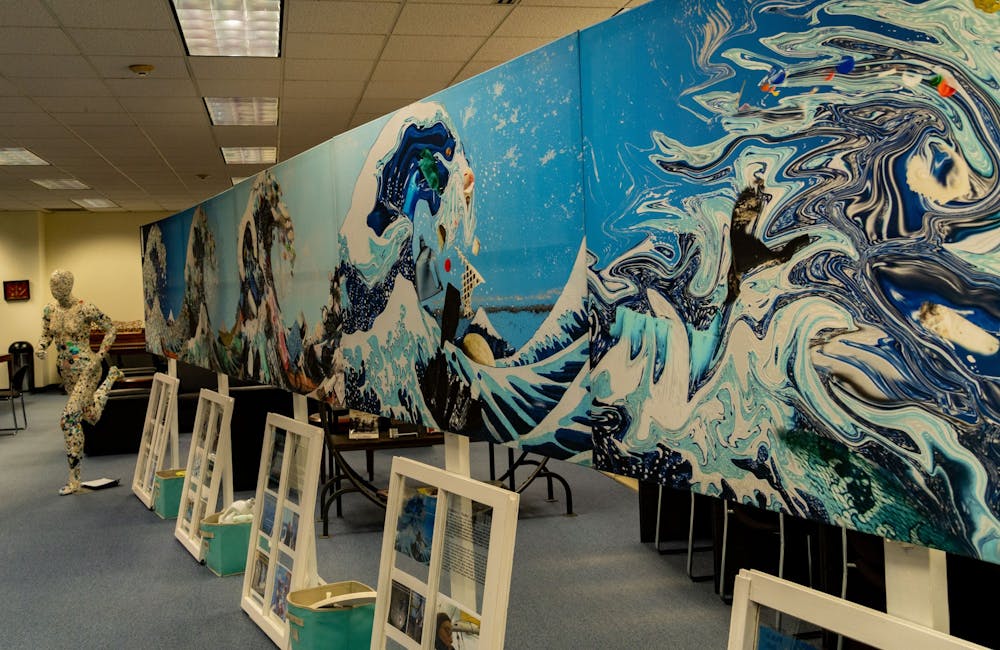Composer Meira Warshauer collaborated with artist and executive director of Plastic Ocean Project, Bonnie Monteleone, in an environmentally focused art exhibit at the USC School of Music.
As a part of the Luise E. Peake Colloquium Series, Warshauer presented a lecture titled “For the Love of Earth: Ocean Calling Trilogy and the Fragility of Nature” on Feb. 25, paired with Monteleone's art exhibit, "What Goes Around Comes Around". The lecture series showcases academics of all kinds, from emerging or underrepresented scholars to graduate students, and provides a way for students, faculty and the Columbia community to engage with one another.
Sarah Williams, associate professor of music history and coordinator of Peake Colloquium, felt the subject matter of Warshauer’s music and Monteleone’s art was a relevant way for students to see how the arts can be involved in social action.
“I haven’t seen anything this, kind of, dynamic before,” Williams said. “I think that … Meira could have the premiere and she could do this talk and that’s all great and everything, but I think that the visual art component, especially that it is three-dimensional, that it’s composed of found objects, of plastic found in the ocean, that’s something.”

Williams also said having Warshauer give a lecture gave students the opportunity to work with “a very accomplished and notable” living composer.
Meira Warshauer, a Harvard, New England Conservatory and USC alumna, said her adoration of the environment inspired the music she wrote.
“My music, which is totally written for the love of Earth, and it’s trying to give people a way to connect through the music, to connect with their own love for this planet that we are the stewards of and the beneficiaries of,” Warshauer said.
Although she had not always seen herself as a composer, she said an influential teacher at the Longy School of Music in Massachusetts convinced her to give music school a chance. By her second year in graduate school, Warshauer decided to throw her hat in the ring and explore her imagination through music.
Drawing inspiration from the Southern Exposure New Music Series, which showcases contemporary classical music of the past 30 years, Warshauer said she wanted to have art showcased with a musical performance.
Warshauer first met Monteleone at the University of North Carolina Wilmington when her art was used on the program for one of Warshauer’s performances. Their common mission of advocating for nature drew them together, and Warshauer felt as though Monteleone’s art was a “good educational dimension” to Ocean Calling.
Bonnie Monteleone, executive director of Plastic Ocean Project and adjunct instructor of environmental science at the University of North Carolina-Wilmington, acts like the “big picture person” at the non-profit organization. She helps design projects and reaches out to scientists who want to work with Plastic Ocean Project.
Monteleone said a trip she took to Kamilo Beach, Hawaii, which is known as one of the dirtiest beaches in the world, was the pivotal moment she knew she had to make a difference.
“It was really standing on that beach and seeing plastic, microplastics, piled up as deep as 10-inches. I just knew I was gonna have to start a nonprofit and knowing what I’ve witnessed, I said ... 'if we don’t do something all beaches are going to look like this,'” Monteleone said.
After this experience, when defending her thesis, Monteleone held a Q&A where someone asked what she planned to do with all the plastic she had collected from the oceans. She recognized how much time and money she had spent collecting it, so she decided to turn it into art rather than throwing it away.
With the plastic collected from the ocean, Monteleone created "What Goes Around Comes Around." Constructed of three 3.5-by-5 foot panels, the art piece spans 25-feet in length.
“At first glance, you see that it's all these pretty colors, you know until you really step in a little closer and you recognize that it's the pollution in the water that's creating the pretty colors,” Monteleone said.
Monteleone said she hopes that her art piece is able to give a tangible experience to Warshauer’s music.
Although Warshauer’s music is not about plastic in the ocean, both artists use their mediums to communicate for the ocean.
“This is where the magic really happens, it’s where the 'unlikelies' meet in the middle,” Monteleone said. “Because I’ve made this art out of plastics I’ve collected in the ocean, because she’s using her art form to communicate for the ocean … my art is doing the same thing.”

